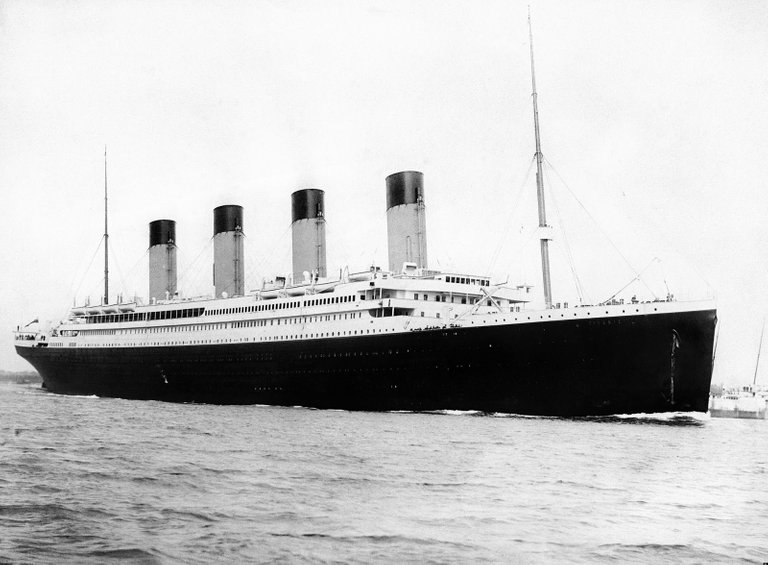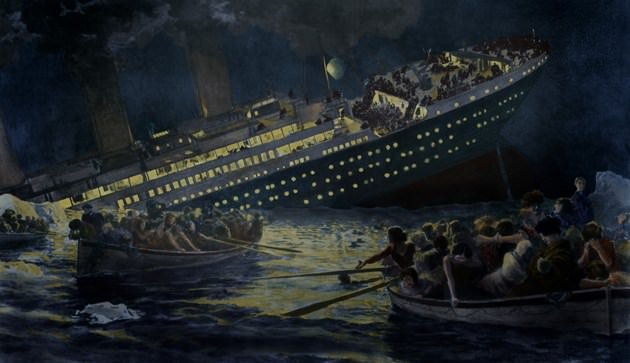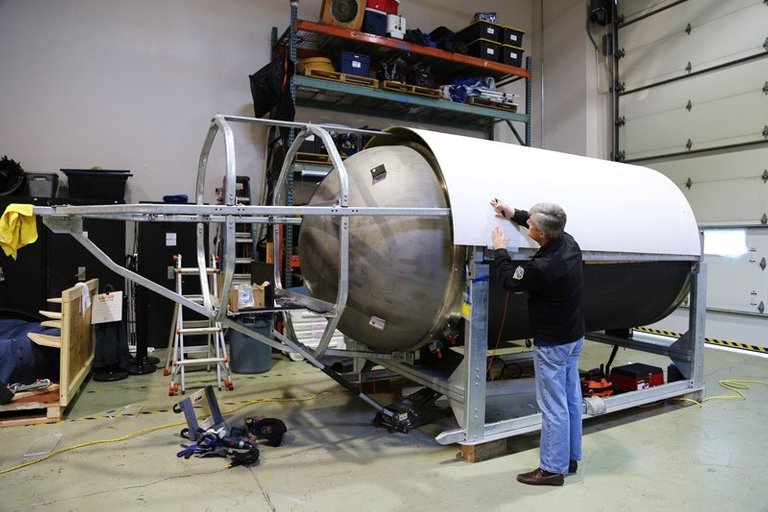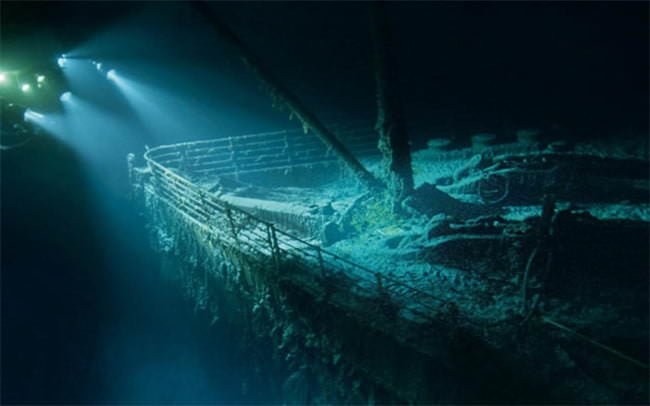
Stockton Rush, a businessman and exploration enthusiast, who once was the youngest jet transport-rated pilot in the world, says more people will scale Mount Everest in one day than have ever seen the Titanic.
This summer, his company, OceanGate, aims to change that by launching a groundbreaking submersible that is expected to travel nearly 13,000 feet underwater to take clients to the famous shipwreck every year. Initial in-water testing of the finished Cyclops 2 vessel is set to begin this month, near the company's office in Everett, Washington.
Today, only a small handful of manned submersibles in the world can travel to such depths, and they are owned by governments. Starting with the wealthy—one seat costs $105,129, the inflation-adjusted price of a first-class Titanic ticket–Rush's mission is to make the deep ocean more accessible to manned "exploration, research and responsible commercialization."
Oceans Deeply talked to Rush, chief executive and co-founder of OceanGate, about his plans and why he thinks many more people need to travel underwater.
What started you on this journey?
This whole process started almost 10 years ago when I wanted to rent a sub, and I found out you couldn't. I started to dig into "why was that?" Why were there not more [manned] subs? Why in a multi-billion-dollar industry of underwater exploration and work was this one tool shrinking? It didn't make sense.
What did you find?
The challenges were mostly related to cost and perception—a perception that they were dangerous, which was wrong, because there hasn't been an injury in a [non-military] manned sub in over 35 years.

The cost was really in how they were operated, around the ship. What we found was that, if you could use any ship—a ship of opportunity—as opposed to a custom ship, of which these are few and far between, you could dramatically reduce the cost of operating a manned sub.
Which other issues did you need to address?
We needed to solve this issue of the expensive ship, and then to go deep, we need to solve [another issue]. Existing subs that go more than 2,000 meters deep are very heavy. They were really never meant to be commercial vehicles. They were research tools. That's why we looked at carbon fiber as a material for the pressure vessel, which gives us all kinds of advantages.
The typical manned sub is a three-person sub, and it weighs 25-30 tons. We take five people, and we weigh less than 10 tons, and we have positive buoyancy, so we have a lot of payload capacity.
After designing the carbon-fiber hull piece, then it was really more about bringing a business perspective to the problem: How do you make the thing cost-effective and versatile enough so you can have enough revenue to make it profitable?
Why manned subs, if we have remotely operated (ROVs) and autonomous underwater vessels (AUVs)?
As you go deeper, the challenges with robots, and the cables that connect them to the surface with ROVs, become harder to deal with. You end up with miles and miles of cables to your robot and that becomes very costly and difficult to handle. As you go deeper, manned subs make more and more sense. We like to refer to them as the world's smartest underwater autonomous vehicles.
With AUVs, it gets down to the fact that you can't have high data communication, at least at this point. You can't get the kind of visual feedback to allow you to actively manage an untethered robot. That means you have to teach the robot to deal with the unknown, and that's a huge challenge. The underwater autonomous vehicles are great for simple tasks. But if you need to go to, say, a wellhead and adjust a valve, they haven't solved that problem yet. That's to say nothing of research on something you don't understand, like a hydrothermal vent. Having the human brain at the work site makes a lot of sense.
How much does the Cyclops 2 cost to build?
We've put tens of millions of dollars into OceanGate to get to this point. There have been multiple pieces of that: the Cyclops 1 submarine and the work we did with Antipodes, which was a sub we acquired about eight years ago. But it's a fraction of what it cost to build Alvin, or any of the other deep-diving subs that are out there.

What's the timeline from now to the Titanic this summer?
The first thing you do with a sub is put it in the water to figure out its actual buoyancy. That's in two weeks. Then, we'll be doing a number of shallow dives, and that allows us to work on the vast majority of the systems. Things like your buoyancy control system, cameras, lights, laser scanners–we'll be testing them locally in the Everett, Washington, area. Then, we'll spend April doing deep dive testing near the Bahamas. Then we go from the Bahamas to St. John's, Newfoundland, where we will head off the Titanic in late June.
What's the scientific value in going to see the Titanic, especially going every year?
Some in the research community say that the Titanic is being eaten away by the rusticles and will disappear in 20 years. Other researchers have said, "no, that's not the case," that the rate of decay is a lot less. That's a big question. What we want to do is get an accurate depiction with the laser scanners of its current condition. Then, every year when we go back, we can see what the actual decay has been.
There's also huge areas of the debris field, multiple square miles, that have not been surveyed. A lot of personal effects that can tell you a lot of the life in the early part of the [20th] century are lying in this debris field.
Then, there's the marine biology. A very, very small part of the ocean has been explored, certainly below a couple of thousand meters. Essentially, any dive you do to the depth you will see something that's never been seen before, and on the Titanic, they found species that they've never found elsewhere.
Do you plan to visit other shipwrecks?
This whole issue of shipwreck decay is one that is very important for nautical archaeology, particularly with wrecks from World War I and World War II. There are tens of thousands of shipwrecks that sank ... with toxic chemicals on them. These things are decaying, and they are called ticking time bombs. This is a big question: How do wrecks decay? We'll get some data from the Titanic, and we've done dives on shallow wrecks. We'd like to dive in the Battle of the Coral Sea [site] in the South Pacific.

We try to find wrecks and sites that are both scientifically interesting, but also exciting for our clients. The way we can fund this, and the way we think that exploration needs to be funded, is that it needs to appeal to wealthy adventure travelers, as well as to the scientific community. If you can find sites that do both, you can add value to mankind and you can find someone who is willing to pay for it.
Do you have lots of interest?
When we announced the Titanic [trip], we sold all the slots. We now have three positions left for 2018, and we have several weeks of our 2019 expedition already filled. There's significant interest. More people will summit Everest in one day than have ever seen the Titanic. If you think about expensive and unusual trips that people take, it's a very rapidly growing market. There's a huge demand for a different kind of experience.
Have there been other commercial trips to the Titanic?
For a deep wreck, it's probably one of the most visited ones. A company called Deep Ocean Expeditions [used to] organize much more touristy trips. They chartered Russian subs, and then people just went and looked at the wreck.
We want to bring back data that's useful for science. Our clients are not tourists, they are active participants. We call them mission specialists. We really think it's much more valuable for us as a company, and much more meaningful for our clients if they are involved in an expedition as opposed to just being a tourist with their butts in the seats. When they are on the sub, they are going to be managing the sonar or they are going to be analyzing the data after the fact. We filter out our clients to make sure that they are wanting to participate in something unique.
Do you think it will one day be common for people to visit the deep sea?
I hope so. It's completely different from scuba diving. It's transformative.
One of the challenges that I think the ocean community has is making the kind of personal connection, the visionary connection that I think space has been able to achieve. You look up every night, and you are able to see it. You have lots of movies about space.
So few people have been underwater. You really have to go there and have that experience, particularly if you do it with a scientist. That is really a critical element that society needs: to be able to be in the medium to understand it. Video alone doesn't do it.
While we are starting obviously with the very wealthy, my hope is that, when someone goes to New York City, they might think, "oh gee, why don't we go dive in the Hudson Canyon and see deep-sea corals?" That might be an option that isn't more expensive than, say, four tickets to a Broadway show.
This article originally appeared on Oceans Deeply. You can find the original here. For important news about our world’s oceans, you can sign up to the Oceans email list.
Interesting! Didn't know about these plans. Are you a fan of Titanic?
Yes, I am a big fan of Titanic.
Me too. Last thing I watched is the Morse correspondence between Titanic, Carpathia and other ships at the night of the shipwreck.
Congratulations @daniyal32! You have completed some achievement on Steemit and have been rewarded with new badge(s) :
Click on any badge to view your own Board of Honor on SteemitBoard.
For more information about SteemitBoard, click here
If you no longer want to receive notifications, reply to this comment with the word
STOPHi! I am a robot. I just upvoted you! I found similar content that readers might be interested in:
https://www.newsdeeply.com/oceans/community/2018/01/05/meet-the-man-launching-private-voyages-to-the-titanic-this-year